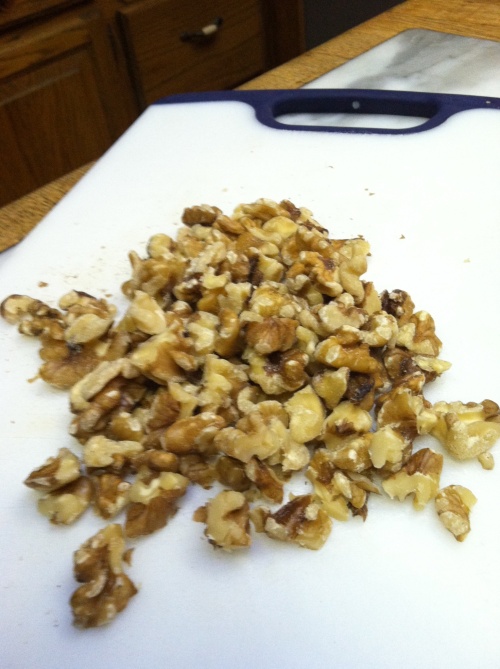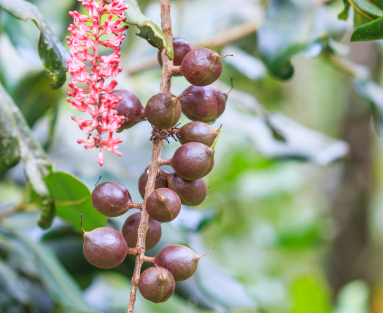
One cup of Waldorfian salad. I doubled the cinnamon in this batch, so yours won’t look quite like this.
Today’s meal is inspired by the classic Waldorf salad, made famous by New York’s Waldorf Hotel over a century ago. The hotel today is called the Waldorf-Astoria.
The primary ingredients are apples, walnuts, and celery.
The original salad was made with mayonnaise, which I’m leaving out since I don’t yet have a paleo-compliant formula. They’re out there, however. Do you have a favorite?

Good source of omega-3 fatty acids
Instead of mayonnaise, we use a dressing—a vinaigrette—made with walnut oil. Walnut oil is attractive in part because it is rich in omega-3 fatty acids: 1.77 grams per tbsp (15 ml). Compared with Paleolithic diets, modern Western diets are too low in omega-3s and too high in omega-6s. You can use your left-over walnut oil the way you’d use olive oil.

I made my dressing in this BPA-laden plastic container
In composing the Paleobetic Diet, my biggest challenge is breakfast. I’m fine eating eggs almost daily, but that may not be your cup ‘o tea. Most of us in America are accustomed to grain-based options like cold cereal, porridge, bagels, donuts, pancakes, granola, and toast. Plus yogurt. Those aren’t paleo, and they have too many carbohydrates for many diabetics. I came up with Waldorfian salad as a low-carb paleo-style breakfast, reminiscent of Brian’s Berry Breakfast.
This recipe makes two large servings of 2 cups (480 ml) each. Small or sedentary folks may well be satisfied with a 1- or 1.5-cup serving.

Apples are the primary source of carbohydrates in this recipe.
Ingredients:
2 apples, raw, medium size, skin on, diced (I used Red Delicious; consider Granny Smith, Fuji, or Gala)
3 celery stalks, 8-inches long (20 cm), diced
1 cup (240 ml) walnuts, broken by hand into small chunks (Option for ? more flavor: toast in a skillet over medium-high heat for 7-10 minutes or in oven (350 F or 175 C) on baking sheet for 10 minutes
1/4 tsp (1.2 ml) black pepper, ground
1/4 tsp (1.2 ml) salt
1.5 tbsp (22 ml) walnut oil
1 tbsp (15 ml) cider vinegar
1/2 tsp (2.5 ml) cinnamon
1/4 tsp (1.2 ml) nutmeg
Instructions:
First make a dressing with the bottom six ingredients. I put mine in a small container with a lid, then shook vigorously. Or you can put them in a small bowel and whisk them.

Walnut pieces
Place the walnuts, apples and celery in a bowel, add the dressing and toss thoroughly. You’re done.
Serve as is, or chill first in the refrigerator. Maybe it was my imagination, but I thought it tasted better after it sat on the counter for 10 minutes. Consider serving on a bed of lettuce (1-2 oz), but if you do, increase your digestible carb count by 1-2 grams.
If you want more calories or protein than this recipe provides, chicken or steak should go well with Waldorfian salad and won’t increase your carb grams.
Number of Servings: 2 (2 cups each)
Nutritional Analysis:
73% fat
21% carbohydrate
6% protein
500 calories
27.5 g carbohydrate
7.6 g fiber
20 g digestible carbohydrate
341 mg sodium
529 mg potassium
Prominent features: High in copper and manganese, low in sodium. This is vegetarian (so much for the paleo diet being meat-centric). On a 2,000 calorie diet, this provides only 15% of the Recommended Dietary Allowance for protein, so you’ll want to eat more protein at some point during the day.
















